How King Tutankhamun Created the Blockbuster Museum Exhibit
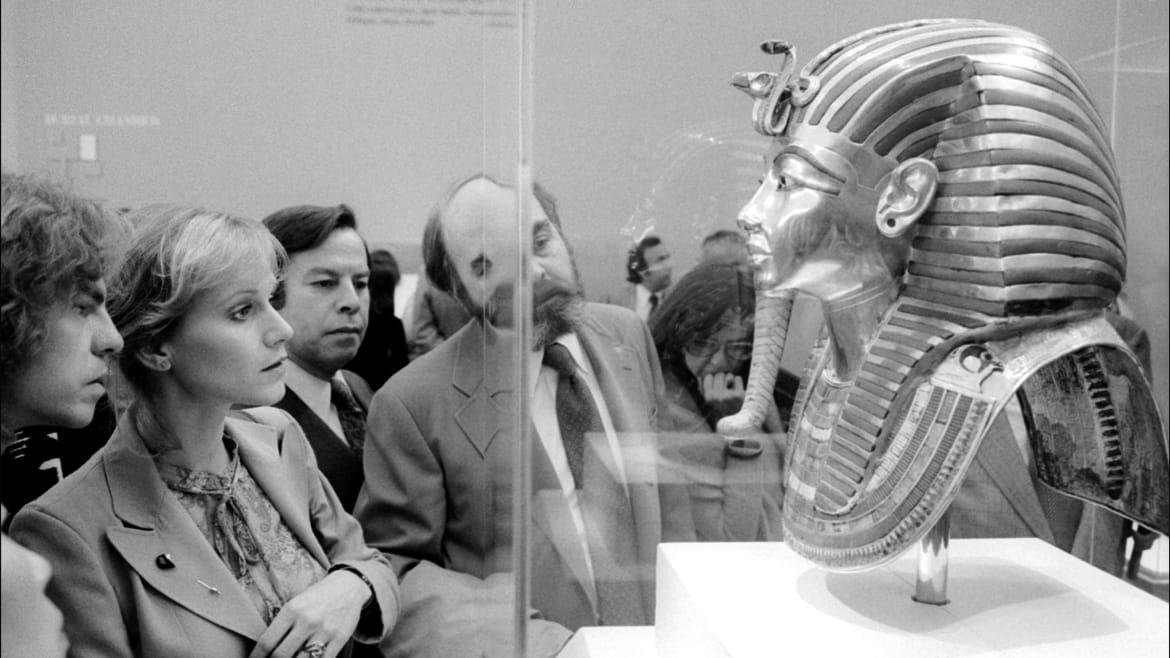
- Oops!Something went wrong.Please try again later.
- Oops!Something went wrong.Please try again later.
- Oops!Something went wrong.Please try again later.
Nov. 4, 2022, marks the 100th anniversary of the discovery of Tutankhamun’s tomb, and soon the world will be inundated with Tut mania: books, TV programs, museum exhibitions, and even an opera about the boy-king. “King Tut” is the most famous of all Egyptian pharaohs, and with good reason. First, there’s the discovery of his tomb—a saga made for the movies. The down-on-his-luck archaeologist (Howard Carter) teams up with a wealthy Englishman (Lord Carnarvon) and for years, they search the Valley of the Kings for the missing tomb—and they find it, packed with treasures. Today, it is still the only king’s tomb found intact in the Valley. It was so crammed with objects that when Carter first peered in and Lord Carnarvon asked him what he could see, the reply was, “Gold, everywhere the glint of gold.” What more could you want? Perhaps a curse.
Soon after the tomb was opened, Lord Carnarvon died in Cairo, on his way home to Highclere Castle. Psychics came out of the woodwork saying they predicted death would come swiftly to those who defiled the ancient Egyptian tomb. Carnarvon actually died of an infected mosquito bite, but that didn’t matter. The curse was a much better story and was carried by newspapers around the world. But that isn’t the end to the story.
Tutankhamun has given us a lot more than the pharaoh’s curse, the famous gold mask, and a tomb in the Valley of the Kings visited by millions of tourists every year. He has even left us a tragic love story. Tutankhamun’s father died when Tut was about 10 years old and to cement the boy’s claim to the throne, he was married to his half-sister, Ankhesenamun, when they were children. It was a marriage created for political reasons, but scenes on painted and gilded objects in the tomb make it clear that as they grew up together, they grew to love each other. They are always shown touching, even hunting together, where an adoring Ankhesenamun holds Tutankhamun’s next arrow for him.
King Tut’s Alien Dagger Conspiracies Have Gotten Insane
But then the music died. Tutankhamun died at around the age of 19, and we don’t know why. We have his mummy, but there is no obvious cause of death. This left Ankhesenamun a teen-aged widow distraught and afraid. We have a frantic letter she wrote to the Hittite king telling him her husband has died and she has no sons. She asks the Hittite to send her one of his sons and she will marry him and make him king of Egypt. She ends the letter saying, “I am afraid, never will I marry a servant of mine.” Is she being forced into a marriage? Why is the Queen of Egypt afraid? We don’t know for sure. We do know that a prince was dispatched but was murdered as he crossed the border into Egypt. Then Ankhesenamun mysteriously disappears, and her tomb has never been found. As I said before, it is a story made for the movies.
If you watch the classic 1932 film The Mummy, starring Boris Karloff, you will find that it is loosely based on the discovery of Tutankhamun and the reincarnated heroine of the film is named Ankhesenamun. The movie, the treasures, and the curse are all part of King Tut’s immense contribution to western civilization, but there’s one more gift, one that may be the most important, and few realize it.
In 1972, to celebrate the 50th anniversary of the discovery of the tomb, the British Museum negotiated an agreement with Egypt to send 50 Tutankhamun objects—including the famous gold mask. The British exhibition set records for attendance in England, and then the exhibition went on to four other countries. Thomas Hoving, the Metropolitan Museum of Art’s flamboyant director, desperately wanted to get King Tut for the Metropolitan Museum, but failed. Then he got lucky; President Richard Nixon stepped in. While the exhibition was in Russia, Nixon asked Egypt’s president Anwar Sadat if the show could come to the United States, and Sadat, wanting to cement good relations with America, agreed.
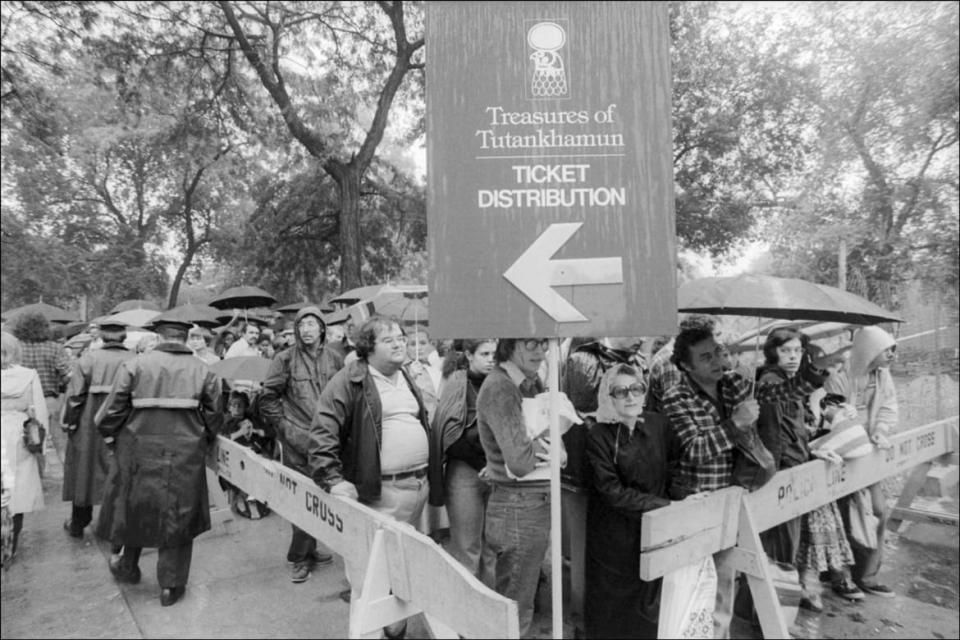
People lined up for tickets to the King Tut exhibit at the Metropolitan Museum of Art.
The exhibition went to five American cities, and the Metropolitan Museum of Art was responsible for organizing it. This created the perfect storm for the invention of the blockbuster. Tutankhamun provided the star power and Hoving the marketing skills. He would select five additional Tut objects to make his exhibition special, would produce the catalog, and perhaps more important, select items to be reproduced and sold in the giftshop. P.T. Barnum had Jumbo the elephant, Hoving had King Tut. It was all very exciting, but Hoving had no idea how difficult the arrangements would be.
Hoving’s first problem was getting an appointment with Dr. Gamal Mokhtar, the director of the Egyptian Antiquities Organization. Although President Sadat had decreed that the United States would get the exhibition, Mokhtar would have the final say on which additional objects could be included, what would be the financial arrangements, and how long each city would have the exhibition. When Hoving arrived for his appointment with Mokhtar, he was shocked by the mayhem in the director’s office. Hoving’s description may seem exaggerated, but I have been in that office when Mokhtar was head of Antiquities and I can attest, it is spot on.
The office was a very large room with peeling paint and oriental rugs, filled with a dozen or more people, each wanting something from Mokhtar. It might be an archaeologist trying to renew his permit to excavate, or a farmer whose cow had fallen into an ancient tomb whose property had been confiscated by the Antiquities Service. Everyone waited his turn and every half hour a servant came in to ask if you wanted tea, coffee, or a Coke. There was no privacy and everyone heard each person plead his case, all while Mokhtar’s two phones were ringing constantly. Hoving arrived at 11 a.m. and was finally able to talk to talk to the director around 1 p.m. The meeting lasted less than a minute.
When Mokhtar saw Hoving he said, “Dr. Hoving, meet me at the Sheraton tonight. Everything will be settled then.” Mokhtar was a great fan of belly dancing and much of his business was conducted after office hours at nightclubs. Everything was not settled at the Sheraton that night, nor the next, nor the next.
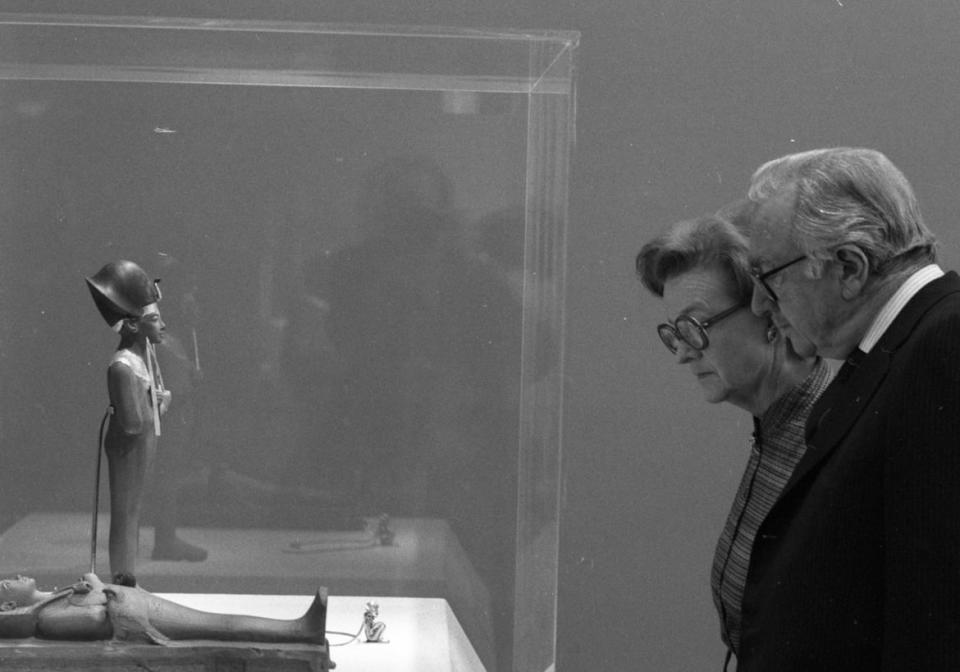
Attendees look over statuettes at the Metropolitan Museum of Art’s King Tut exhibit.
All kinds of details for the exhibition had to be worked out and Mokhtar was not a decisive man. When Hoving gave Mokhtar a list of the additional objects he wanted to borrow, Mokhtar said he would consider it. When Mokhtar asked how much admission the Metropolitan was going to charge, Hoving explained that the Metropolitan Museum did not charge admission. This convinced Mokhtar that there could be no exhibition. Where would the money for the Egyptian Antiquities Organization come from? The blockbuster had not yet been invented. Who knew that there was a fortune in gift shop sales, catalogs, and sponsors who wanted to be associated with the glamour of Tutankhamun?
Hoving explained that items such as Hermes scarves with a Tutankhamun design could raise thousands and thousands of dollars. Mokhtar asked if he could have one. Hoving promised a dozen. In the end, Hoving said that he was sure he could contribute $1.4 million to the Antiquities Organization for their cooperation. Mokhtar said he would consider it and suggested Hoving should return in a month.
When Hoving returned, there were more nocturnal meetings, this time with some progress. Hoving had just concluded agreements with the Franklin Mint and Boehm Porcelains to produce souvenirs that would bring in millions of dollars. Mokhtar was thrilled. Hoving explained that he would have to return to Cairo with a team to photograph the objects for the catalog, make molds for the replicas that would be sold in the gift shop, and take careful measurements so the display cases could be constructed. But, as was often the case in those days, there was no electricity in the museum just then, and they would need to set up lights for photography. “No problem, it will be on when you return.”
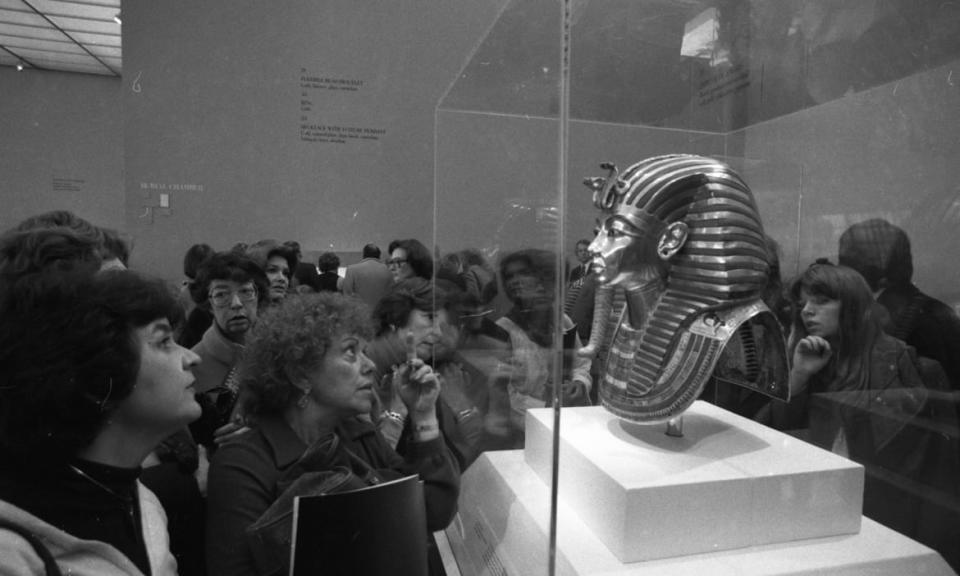
The gold mask of Tutankhamun.
Hoving and his team returned three months later, in January 1975. Still no electricity but “it was expected in three months.” The director of the Metropolitan Museum of Art hit the ceiling. After his anger subsided, it was replaced by fear, and then finally, by a plan. On a previous trip, Hoving had met Fuad el-Orabi, perhaps the only man in Egypt who had the knowledge and power to solve the problem. He called him immediately. El-Orabi was director of the Sound and Light show at the Great Pyramid. Each night thousands of tourists bought tickets to sit on folding chairs on the Giza Plateau to watch colored lights flashed on the pyramids while a narrator told of the pyramids’ age and mystery. The show is dramatic, and tourists love it and for decades it has been a financial success. Hoving figured that the show required a great deal of electricity and know-how to keep it running flawlessly. He offered El-Orabi a paid position on the Met’s team as an electrical consultant. El-Orabi told Hoving to meet him outside the back wall of the Egyptian Museum at 11:30 that night.
At the specified time, a truck pulled up to the deserted street and el-Orabi, two technicians, and a huge spool of electrical cable emerged. The men began digging at the foot of a streetlight. They were going to splice into the Cairo lighting system, run the cable over the museum wall up to the museum roof, through a broken Museum skylight, and drop it into the room in which the Met team had set up their studio. When Hoving expressed concerns about splicing into the live high-voltage wires of the Cairo’s streetlights, el-Orabi looked at his watch and simply said, “Be patient, Dr. Hoving.” Soon the lights for several blocks around the Museum began to dim and then went out. The next morning museum officials were amazed to find Hoving’s team, lights ablaze, photographing Tutankhamun’s treasures.
The quest to obtain “The Treasures of Tutankhamun” exhibition was a constant struggle, but sometimes it was a funny struggle. One of the extra five objects Hoving wanted for Tutankhamen’s American tour was the statue of Selket, one of the four goddesses who protected the shrine containing the boy-king’s internal organs. She would go on to become a best seller in the gift shop, but not without difficulty.
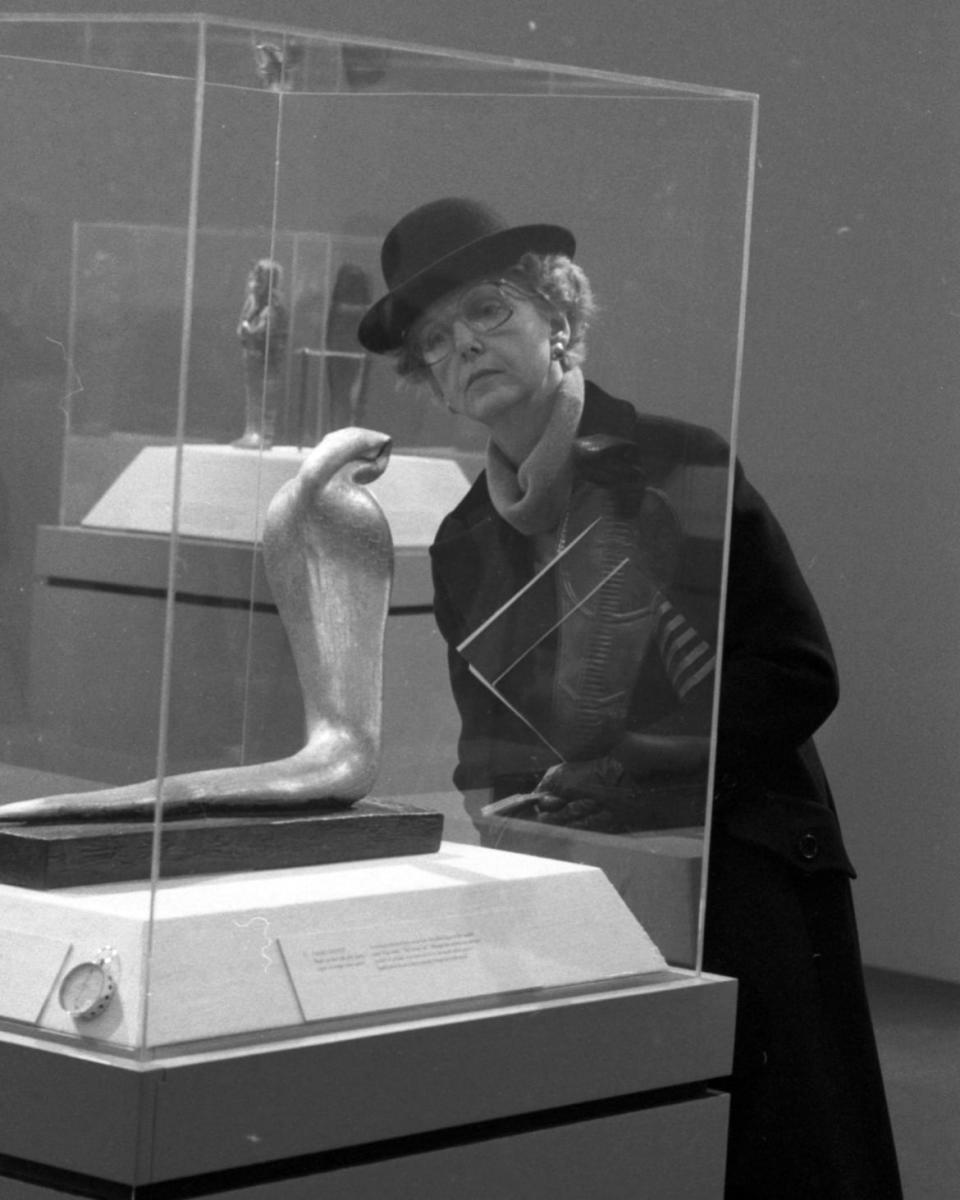
An attendee views a gold cobra statue of Netjer-Ankh.
When Hoving explained that he wanted the Selket statue for the exhibition, he was quickly rebuffed—the four statues and the base they rested on were all carved from one piece of wood and couldn’t be separated. This was nonsense, and Hoving knew it. He had studied the 1920s photographs of the excavation and had seen the statues being carried out separately from the tomb. He offered his Egyptian colleagues a bet they couldn’t refuse. If he could lift the Selket out of the base, he could have it for the show and would buy everyone dinner at Cairo’s best restaurant. If he couldn’t lift it, he would buy them two dinners at the restaurant. It was a win-win for the Egyptians, so Hoving donned his white curatorial gloves, walked over to the shrine, grasped the Selket and lifted. She came right out, and Hoving got his girl. Later, the Selket statue would be reproduced in three sizes with the largest selling in the gift shop for more than $1,500. These replicas are still available in the gift ship today, 50 years later.
The back and forth trips to Egypt, the endless negotiations with Egyptian authorities, the scheduling of the exhibition for five cities, all took a toll on Hoving. His Egyptian adventure was not something he remembered fondly. When I met him for the first time, at a dinner at my university, he had just returned from Egypt and was shell-shocked. Being the only Egyptologist on campus, I was seated next to Hoving.
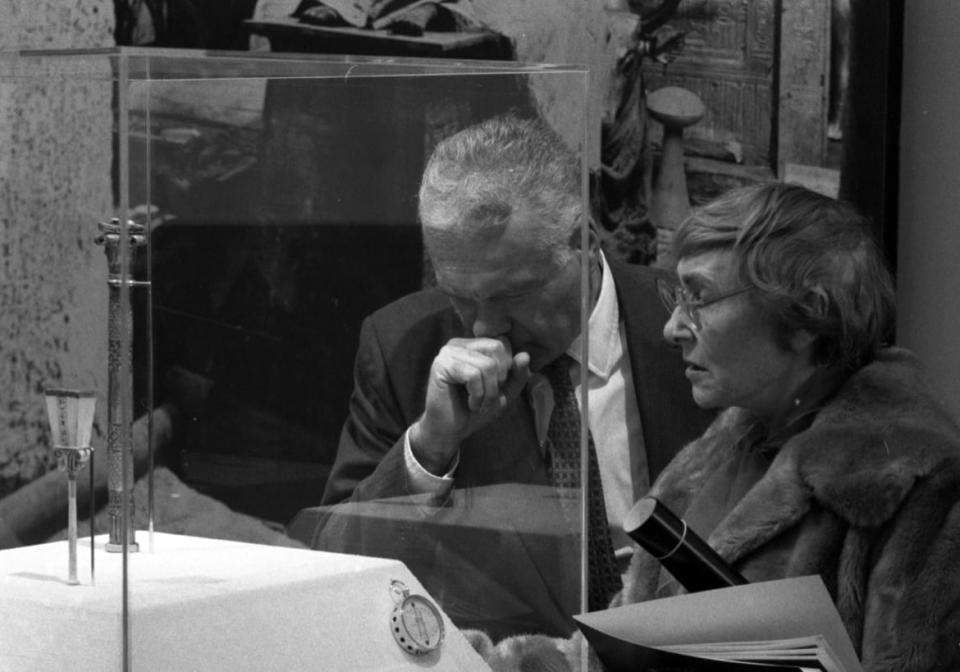
Attendees browse artifacts at the Metropolitan Museum of Art in New York City.
The first thing he asked was if I had been to Mokhtar’s office on Ramses Street. When I said “yes,” he figured he had a sympathetic ear and over dinner described some of the details of his negotiations. I was amazed at the magnitude of the deal. It wasn’t just New York that was going to get the exhibition, but it was to travel to five venues and each was going to pay millions of dollars to get the exhibition. Like Mokhtar, I wondered, where the museums were going to get the money. It was hard enough for them to get a million dollars to buy a painting or a statue. I just didn’t understand the finances. I didn’t know it, but I was in on the birth of the blockbuster.
Although still exhausted from his Egyptian ordeals, Hoving was very excited that the exhibition was finally going to happen and said to me, “You had better call Christine if you want to book tickets for your students.” Christine Lilyquist was the curator of the Met’s Egyptian collection and a friend, but what did he mean? Tickets for an exhibition at the Metropolitan Museum of Art? It was a fabulous old museum with many important collections, but it was never crowded. You never needed tickets for an exhibition. This was all new territory, and I couldn’t wrap my little academic brain around how a blockbuster would work.
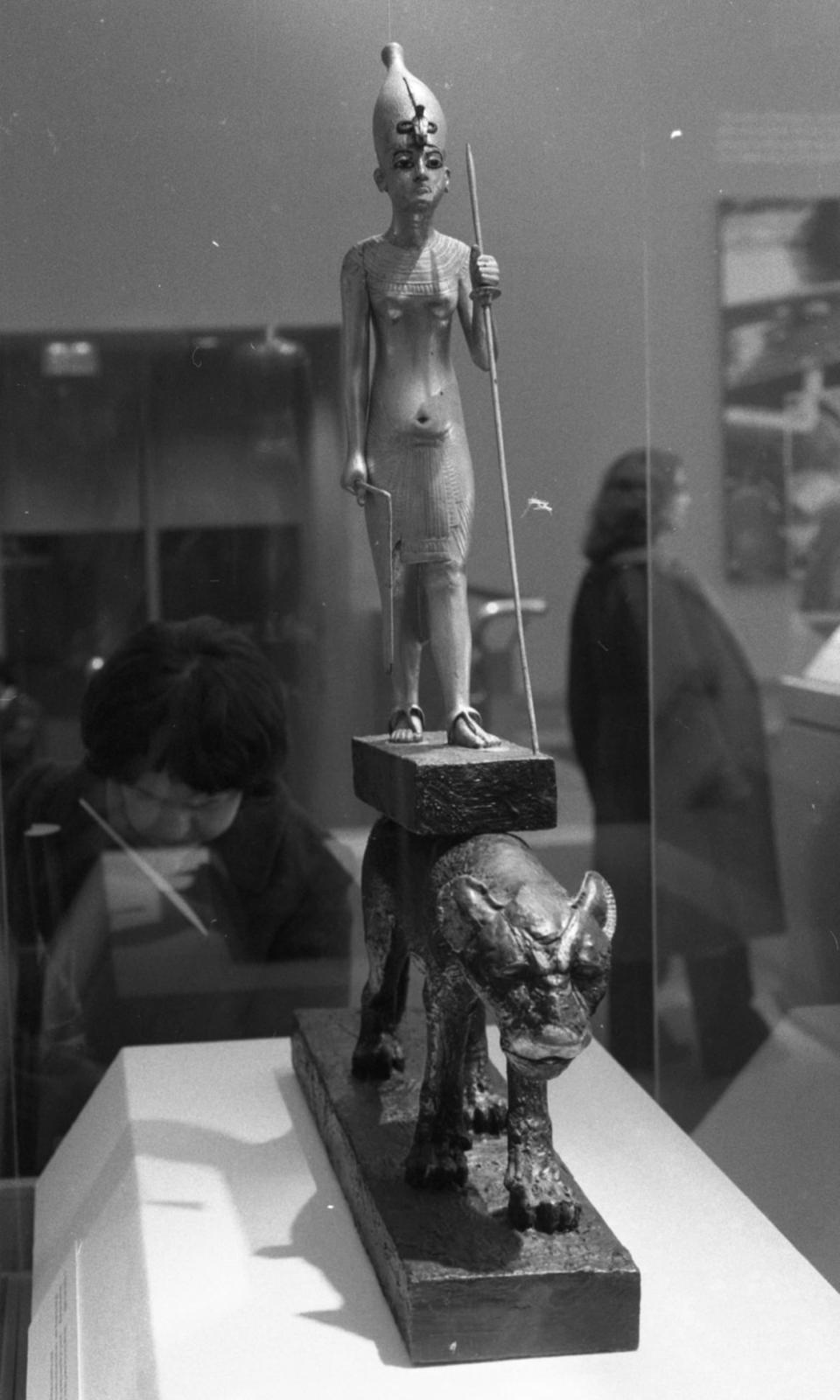
A statuette of Tutankhamun standing on a panther.
When I asked how much tickets would cost, the whole thing became even more puzzling. They were free. Hoving explained that because the Met received considerable amounts of money from New York City, their charter stipulated that they couldn’t charge admission. The tickets weren’t for revenue, they were for crowd control. So many people were expected to visit the exhibition that they would need to obtain timed tickets issued in advance, to avoid massive crowding.
As this new concept was being explained to me, it was getting curiouser and curiouser. If the Met was paying millions to get the exhibition, and the tickets were free, how would they get their money back? “In the gift shop.” Again, I didn’t get it. This was before gift shops were fashionable places to shop, before they stocked designer scarves and high-priced souvenirs. Museum gift shops were places where you bought postcards as souvenirs. I was acting like Dr. Mokhtar had months earlier. When Hoving was telling me about it, I had no idea that “The Treasures of Tutankhamun” would change the world of museums forever. The thousand-dollar museum souvenir had been born.
When I finally went to see the show, I was not disappointed. Each item was beautifully displayed and the timed ticketing system worked; it was crowded, but not too crowded. You could see everything, but you had the feeling you were part of a very special cultural event.
The place that was crowded was the gift shop. Everyone wanted souvenirs, and there were high-ticket items the likes of which had not been seen in museum gift shops before. Hoving had pulled it off. Tutankhamun was a success. So successful that on April 22, 1978, he made an appearance on Saturday Night Live when Steve Martin sang his now famous “King Tut.” Those who remember the skit probably recall the unforgettable lines “Born in Arizona, moved to Babylonia, King Tut.” But few remember that the lyrics are mostly about the museum exhibition.
Now when he was a young man,
He never thought he’d see,
People stand in line to see the boy king...
(King Tut) Now if I’d known
They’d line up to see him,
I’d taken all my money
And bought me a museum (King Tut)
Hoving must have been thrilled.
In the end, the Egyptian Antiquities Organization received $11 million as their share of the proceeds, and the Metropolitan Museum made money and greatly increased its membership. Soon after the “Treasures of Tutankhamun,” Hoving left the Metropolitan Museum. During his tenure there, he totally revitalized the place. He increased attendance, convinced wealthy collectors to give their collections to the museum, and with the help of Tutankhamun, invented the blockbuster exhibit.
Bob Brier, Senior Research Fellow at the C.W. Post Campus of Long Island University, is one of the world’s foremost Egyptologists. His latest book, Tutankhamun and the Tomb that Changed the World, was published by Oxford University Press in October.
Get the Daily Beast's biggest scoops and scandals delivered right to your inbox. Sign up now.
Stay informed and gain unlimited access to the Daily Beast's unmatched reporting. Subscribe now.

